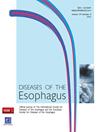41. HIGH COMPREHENSIVE COMPLICATION INDEX AFTER MINIMALLY INVASIVE ESOPHAGECTOMY ASSOCIATED WITH POOR SHORT-TERM AND LONG-TERM OUTCOME: A PROPENSITY SCORE MATCHING ANALYSIS
IF 2.3
3区 医学
Q3 GASTROENTEROLOGY & HEPATOLOGY
引用次数: 0
Abstract
The comprehensive complication index (CCI) is a new index to comprehensively and systematically evaluate complication severity. The objective of this study was to evaluate the predictive ability of CCI on short—and long-term overall survival(OS) in patients with esophageal squamous cell carcinoma (ESCC) undergoing minimally invasive esophagectomy (MIE) based on a propensity Score Matching (PSM) analysis. A total of 356 patients treated with radical MIE from 2013 to 2017 were included, and the primary outcome was OS, and the secondary outcomes were postoperative hospital stay and hospital costs. Firstly, the optimla cut-off value of CCI was determined by X-tile. PSM was used to balance the baseline characteristics. Second, we compared postoperative hospital stay and hospital costs between high- and low-CCI group. Third, the Kaplan–Meier survival curve was used to analyze survival difference. Fourth, univariate and multivariate Cox analysis was used to explore the independent risk factors of OS. The CCI > 24.2 was defined as high-CCI group and CCI≦24.2 was defined as low-CCI group. The high-CCI group had more hospital costs and longer hospital stay than the low-CCI group both before and after PSM (p < 0.001). The K-M analysis indicated that patients with high CCI had worse prognosis both before and after PSM (before matching: P < 0.001; after matching: P = 0.04). CCI was determined as independent prognostic factor both before and after PSM (before PSM, P = 0.002; after PSM, P = 0.025). The CCI could quantify postoperative complications after esophagectomy. High CCI is associated with longer hospital stay and hospitalization costs, and is an independent risk factor for poor OS.41. 微创食管切除术后综合并发症指数高与短期和长期预后差相关:倾向评分匹配分析
综合并发症指数(CCI)是一种综合系统评价并发症严重程度的新指标。本研究的目的是基于倾向评分匹配(PSM)分析,评估CCI对食管鳞状细胞癌(ESCC)微创食管切除术(MIE)患者短期和长期总生存(OS)的预测能力。纳入2013 - 2017年接受根治性MIE治疗的356例患者,主要终点为OS,次要终点为术后住院时间和住院费用。首先,通过X-tile确定CCI的最佳临界值。PSM用于平衡基线特征。其次,我们比较了高cci组和低cci组的术后住院时间和住院费用。第三,采用Kaplan-Meier生存曲线分析生存差异。第四,采用单因素和多因素Cox分析探讨OS的独立危险因素。以CCI≦24.2为高CCI组,以CCI≦24.2为低CCI组。高cci组在PSM前后的住院费用和住院时间均高于低cci组(p < 0.001)。K-M分析显示,高CCI患者在PSM前后预后均较差(配对前:P < 0.001;配对后:P = 0.04)。在PSM前后,CCI均被确定为独立预后因素(PSM前,P = 0.002;PSM后,P = 0.025)。CCI可以量化食管切除术后的并发症。高CCI与较长的住院时间和住院费用相关,是不良OS的独立危险因素。
本文章由计算机程序翻译,如有差异,请以英文原文为准。
求助全文
约1分钟内获得全文
求助全文
来源期刊

Diseases of the Esophagus
医学-胃肠肝病学
CiteScore
5.30
自引率
7.70%
发文量
568
审稿时长
6 months
期刊介绍:
Diseases of the Esophagus covers all aspects of the esophagus - etiology, investigation and diagnosis, and both medical and surgical treatment.
 求助内容:
求助内容: 应助结果提醒方式:
应助结果提醒方式:


